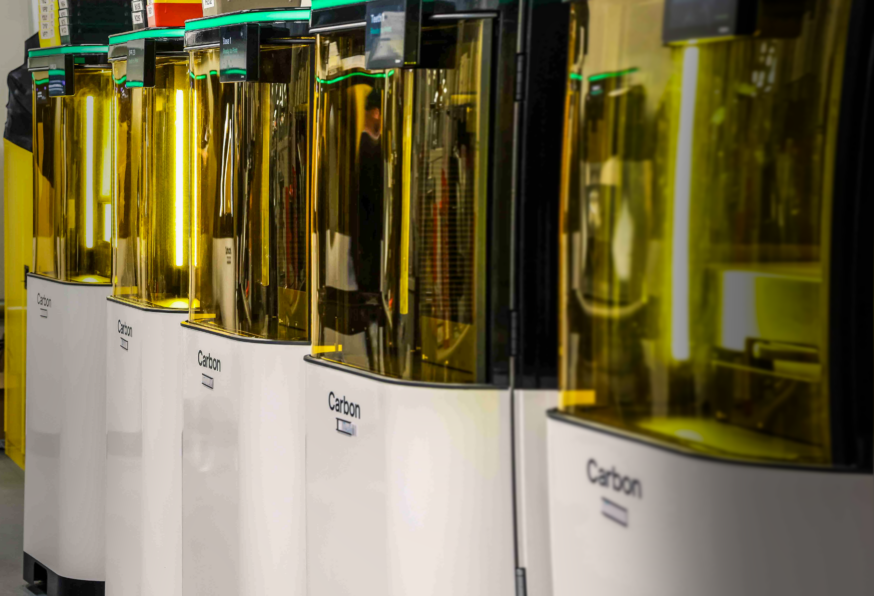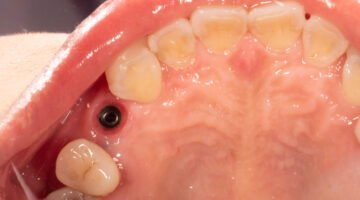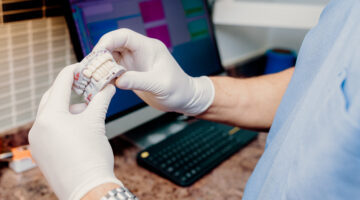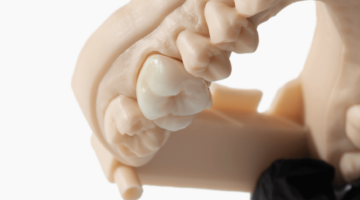3D printing was first introduced in the 1980s and promised a world where custom manufacturing would become mainstream. Today, that promise has been mostly realized. Hobbyists and engineers are able to utilize 3D printing to produce parts and prototypes rapidly. While likely not intentional at inception, 3D printing has unlocked digital workflows in the dental industry and today is the best and prolific mass-market use of 3D printing technology. Dental is custom prosthetic manufacturing. As digital technologies and workflows become common, 3D printing capabilities are not just “nice to have” but a requirement for dental production. While 3D printing has been used in dentistry for over 20 years, today it’s an accessible (especially with the right lab partner) and critically important capability for dental technology. Let’s look at the best dental 3D printers.
What type of 3D printers are used in dentistry?
Not all 3D printers, processes, and technologies are the same. The dental industry has very strict requirements that only a small subset of 3D printers meet. While it is application-dependent, dental 3D printers must be extremely accurate, consistent, and (for direct-use applications) meet the standards needed for biocompatible validation. The second unique requirement is where it’s being used in industry, a solution made for a dental practice will not work as well in a dental laboratory and vice versa. A dental practice will thrive with a 3D printing ecosystem that is intuitive, fast, and meets biocompatibility processing requirements with little room for error. A dental laboratory relies on a 3D printing system to be run consistently, at scale, with little downtime day after day.
The majority of dental 3D printers use, in one form or another, SLA (Stereolithography) technology. Fundamentally SLA, regardless if it uses a DLP projector, LED mask, or a laser, uses photopolymer resins that change from a liquid to a solid when exposed to UV energy (vat photopolymerisation). The advantage of SLA over other 3D printing technologies is its accuracy and surface quality which affect consistency of fit and patient experience. There are also several dental jetting technologies that have some unique attributes and are quite different from vat-based SLA; it still utilizes similar photopolymer resins but places the liquid material through nozzles like an inkjet printer, but layer by layer.
There are no easy answers in dental 3D printing, the idea and concept of creating parts layer by layer is fairly straightforward, whereas in reality it’s a complex system to control UV energy that is greatly dependent on the inputs and process surrounding it. Each 3D printer system has its own advantages and disadvantages. To find the best 3D printer in dental is first an exercise in what are your unique requirements.
At our Dandy production centers or laboratories, we utilize industrial-level Carbon 3D printers with Keystone and Dentsply Lucitone resins. The Carbon M3 is the premier solution for dental 3D printing with active calibration and monitoring services as well as unmatched accuracy and consistency across a fleet of equipment. Additionally, while always following their validated workflow requirements, we also commit a large amount of research and development resources to the manufacturability of 3D printed products. This means fully testing new products at our R&D facility using rigorous accuracy and fit specifications that generate our design software setting values and standard processes for print setup, post-processing, and finishing. This extra validation ensures that the production team has an end-to-end solution, helping smooth the launch of new products and set clear expectations throughout.
In our opinion and experience this is our list of the top 3D printing solutions for a dental practice. They are all capable of producing a wide range of dental applications, affordable and as easy as possible to run on a daily basis.
The best dental 3D printers
SprintRay – Pro95 S and Pro55 S
Pros
- Completely focused on dental practice-based 3D printing
- Polished ecosystem and workflow for dental
- Technical support / Continuing education
- Good material and resin portfolio
Asiga – Max UV
Pros
- Open 3D printing platform
- Largest material and resin portfolio on the market
- Ideal for the “tinkerer”
Formlabs – Form 3B
Pros
- Polished ecosystem and workflow
- No need to pour or mix resins
- Easy to own and operate, proven track record
Dentsply Sirona – Primeprint
Pros
- Polished ecosystem and workflow for dental
- Has post-process automation unlike any other system on the market
- Company on forefront of chairside solutions with CEREC for the last 20+ years
What to know when thinking about a dental 3D printer
Regardless of your requirements or what 3D printer and ecosystem looks best for your situation, preparing your business outside of the actual purchase is the best investment you can make.
Digital inputs
First and foremost, you need to be taking digital impressions. Unless you plan to endure the cumbersome practice of pouring models from physical impressions and using a desktop 3D scanner, you’ll need to be able to capture digital impressions with a 3D intraoral scanner. If you are interested in guided surgery, you’ll also need CBCT data in addition to the digital impression. If you don’t already have a CBCT scanner, and want to be able to do guided surgery, it could be a major barrier to entry.
CAD
Computer-aided design or CAD software is a requirement to be able to 3D print. CAD can be something done in practice or outsourced to a design service or automation but the cost, quality, and speed vary. For example, if you want to 3D print basic diagnostic models from your digital impressions, there are many built-in or free solutions available. Inversely if you want to be able to design surgical guides the software on the market can be expensive and difficult to master, especially if you are looking to have members of your staff take this work on with finalization of treatment plans done by doctors. Finally, outsourcing CAD design, while there are many situations where this makes complete sense at first but it is not instantaneous, you’ll be losing creative control, and it might feel burdensome in meeting your specifications, without paying a premium to high-service providers which are often domestically based.
Staff
Regretfully, 3D printing is not yet one button production, you’ll need to commit pretty significant labor to manage, run, and maintain a full 3D printing workflow. Do you have team capacity or will you need to hire? Even more importantly, is the team clear on what doing in-house production will actually require and with all new things, get them comfortable or even excited about the potential of 3D printing? It is paramount that you educate yourself and team members by watching webinars or videos that go through the entire print process in detail, regardless of the type or brand of system. Lastly, consider attending trade shows and presentations, which are great for learning but you will also find other peers and be able to learn from their experiences adopting the technology.
Space and safety
Physical space, workflow, and safety. While the 3D printer and its post-processing equipment is fairly compact, you need more room to operate than you’d expect to have a smooth operation.
3D printed parts using resins or photopolymers need to be cleaned of excess material that remains on the part. After printing, but before UV post-curing, isopropyl alcohol (IPA) is used to wash or clean the resin away from the surfaces of the 3D printed part. Be prepared with any amount of production will require gallons of IPA per month and needs to be stored for inventory but also waste. Purchasing IPA from the local drug store won’t work, you’ll need to find a large volume supplier and remember hazardous materials, like IPA, is ground shipping only. When the resin is used and ready for disposal, a local chemical recycling service must be tendered.
Working space is often underestimated. You’ll need a decent amount of table or bench space to post-process parts and a variety of tools like handpieces, depending on the application. Table surfaces cannot be made of a porous material, stainless steel or granite is best. The 3D printer and post-processing equipment requires enough room to be easily cleaned daily, otherwise it becomes a toxic, sticky, mess. Skin should never be in contact with the resin, always use gloves, eye protection, and even a mask or respirator or air evacuation system. When 3D printed parts are fully printed and post-processed they can be safe enough for oral use, but in its raw state it is extremely toxic with fumes. Mishandling photopolymer resins can result in becoming allergic from exposure to the point where you cannot even be in the same room of these materials and their post-processing.
Prepare to build a small dental laboratory
We know that you are an expert doctor, and while running your practice you have become an expert bookkeeper, human resources department, marketer, and sometimes snow removal specialist. The logistics, maintenance, and production of 3D printed appliances and parts requires all the same functions a dental laboratory has. You need to always be prepared for troubleshooting issues and constant calibration when things start to go wrong. Improper use of 3D printing will result in poor quality, misfitting, appliances. The work to build a functional 3D printing operation in practice should be built from the ground up, considering all things.
3D printing with Dandy’s lab
At Dandy we’ve made major investments in industrial equipment, highly skilled people, and refinement of processes around producing consistent, high quality, and safe 3D printed appliances and parts. Desktop dental 3D printing has come a long way and the future is bright but it will likely be many years before the 3D print process becomes truly ready for wide use in practice. Additionally, while many dental applications and their materials have matured to a point where it truly makes sense for patient treatment, there are still a lot of applications that need future resin and materials development to be equal to or better than their milled counterparts. 3D printing is inevitable for all dental indications, but it’s important to remember we are still very early in the maturity of software, hardware, and material science.
Whether your practice likes to equip the latest and greatest technology, or you’re interested in the type of technology your dental lab could be using, 3D printing in dentistry is helping doctors see faster turnaround times on dental models, dentures, and even 3D printed night guards. Partnering with a lab that has done the research on the 3D printers in the market and have the capacity and technicians to ensure the best outcomes can have your practice still sit at the cutting edge without having to invest your time, money, and people power to 3D printing in your dental practice. Looking for a lab that’s done the research? We’re Dandy, your lab partner in digital dentistry. Learn more about our lab services and receive a free intraoral scanner when you sign on today!



